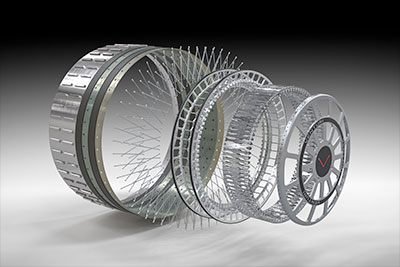Astrolab's FLEX Rover to be Launched on Upcoming SpaceX Mission to the MoonFLEX rover expected to be the largest and most capable rover ever to travel to the Moon
Today (March 23, 2023) Venturi Astrolab, Inc. (Astrolab), announced it has reached an agreement with Space Exploration Technologies (SpaceX) for the company to transport Astrolab's Flexible Logistics and Exploration (FLEX) rover on an upcoming mission to the Moon. SpaceX will use the Starship launch and landing system for this mission as soon as mid-2026.

Above: Testing of Astrolab's FLEX Rover and its robotic arm. The testing was conducted near Death Valley, Calif. (Astrolab)
Upon completion of this mission, Astrolab's FLEX will become the largest and most capable rover to ever travel to the Moon. With a maximum combined rover and cargo mass of more than two tons, the FLEX rover is nearly three times the mass of its largest predecessor. This increased capacity provides significantly more opportunities to conduct scientific experiments and commercial endeavors on the lunar surface. Astrolab has already signed several customer agreements to carry payloads on this mission. The company expects to release details of these agreements later this spring.
FLEX is more than a rover, it's a logistics system for missions to the Moon and Mars

Historically, planetary rovers have been custom designed for each specific mission. These missions typically have occurred around once every ten years. But with the rapid increase in launch cadence along with the significant increases in payload capacity of launch vehicles, this bespoke approach to rover design is no longer practical or efficient.
That's why Astrolab designed the FLEX rover to transport and deploy payloads in a modular system. Astrolab seeks to prove the benefits of having a highly capable and versatile rover to establish infrastructure, conduct high-priority science, and deploy technology demos and other specialized systems on the lunar surface. Astrolab plans for this rover to be the first in a fleet of FLEX rovers on the lunar surface that will accelerate the vision of creating a permanent human presence on the Moon, and eventually Mars.
"Our Astrolab team has created much more than a rover for use on the Moon or Mars," said Jaret Matthews, Founder and CEO of Astrolab. "We've created a logistics system that can accommodate a wide variety of cargo. We expect that this approach will help establish a permanent lunar outpost on the Moon at a lower cost and in less time than previously envisioned. We are delighted that this contract with SpaceX will allow Astrolab to demonstrate the advantages of the FLEX rover and its modular payload system."
"Starship is designed to transport large amounts of cargo, including rovers, to the Moon and Mars for research and exploration," said Tom Ochinero, Senior Vice President, Commercial Business, SpaceX. "Developing sustainable outposts will require lunar logistics and transportation on the surface of the Moon, like what Astrolab offers. We look forward to working with the Astrolab team to deliver their FLEX Rover to the surface of the Moon."
In addition to being able to operate FLEX on the lunar surface from Earth, Astrolab designed the vehicle to serve as an unpressurized rover for a crew of two astronauts on the lunar surface. This design is compatible with NASA's requirements for its Lunar Terrain Vehicle (LTV), the rover which will be a standard component to the agency's Artemis program long-term.

Testing is ongoing
FLEX is more than just a concept. Last year, the Astrolab team began testing a full-scale, fully-functional terrestrial prototype of the FLEX rover in the California desert. Tests included both crewed and telerobotic operations, deployment of a variety of large payloads, science operations with its robotic arm, and engineering testing of the rover's mobility performance in challenging terrain. Testing has continued in lunar analog sites around California throughout 2022 and into this year.

















